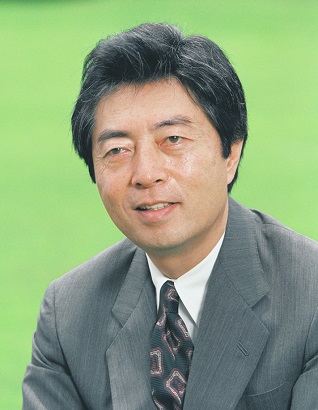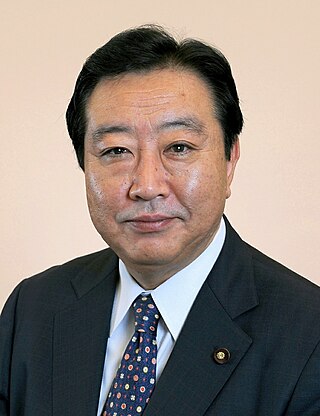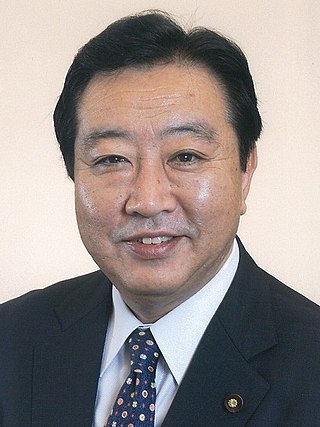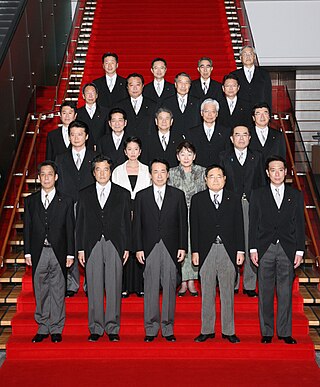
The politics of Japan are conducted in a framework of a dominant-party bicameral parliamentary representative democratic constitutional monarchy. A hereditary monarch, currently Emperor Naruhito, serves as head of state while the Prime Minister of Japan, currently Shigeru Ishiba since 2024, serves as the elected head of government.

Morihiro Hosokawa is a Japanese politician who was Prime Minister of Japan from 1993 to 1994, leading a coalition government which was the first non-Liberal Democratic Party (LDP) government of Japan since 1955. After successfully implementing various election and trade reforms, he stepped down from the role of Prime Minister in early 1994. He later ran unsuccessfully as a candidate for Governor of Tokyo in the February 2014 gubernatorial election as an independent supported by the Democratic Party of Japan. He has been, since 2005, the head of the Kumamoto-Hosokawa clan, one of the former noble families of Japan.

The Democratic Party of Japan was a centrist to centre-left, liberal or social-liberal political party in Japan from 1998 to 2016.

Naoto Kan is a Japanese former politician who served as Prime Minister of Japan and President of the Democratic Party of Japan (DPJ) from June 2010 to September 2011.

Ichirō Ozawa is a Japanese politician and has been a member of the House of Representatives since 1969, representing the Iwate 3rd district. He is often dubbed the "Shadow Shōgun" due to his back-room influence.

Hirohisa Fujii was a Japanese politician who was a member of the House of Councillors from 1977 to 1986, and of the House of Representatives from 1990 to 2012. He served two terms as Minister of Finance, and as Secretary General of the Liberal Party and the Democratic Party of Japan.

Sadakazu Tanigaki is a Japanese politician who served as a member of the House of Representatives from 1983 to 2017, as Minister of Finance from 2003 to 2006, as President of the Liberal Democratic Party and Leader of the Opposition from 2009 to 2012, as Minister of Justice from 2012 to 2014, and as LDP Secretary-General from 2014 to 2016. He was only the second LDP leader who was not simultaneously Prime Minister of Japan. He retired from politics following a spinal cord injury in 2016 that saw him using a wheelchair.

General elections were held in Japan on 20 October 1996. A coalition of the Liberal Democratic Party, New Party Sakigake and the Social Democratic Party, led by incumbent Prime Minister Ryutaro Hashimoto of the LDP won the most seats.

Yōichi Masuzoe is a Japanese politician who was elected to the position of governor of Tokyo in 2014 and resigned in June 2016 due to the misuse of public funds. He was previously a member of the Japanese House of Councillors and the Japanese Minister of Health, Labor, and Welfare. Before entering politics, he became well known in Japan as a television commentator on political issues.

Yoshihiko Noda is a Japanese politician. He is the current leader of the Constitutional Democratic Party of Japan (CDP), and has been a member of the House of Representatives since 2000. From 2011 to 2012, he was the Prime Minister of Japan.

Goshi Hosono is a Japanese politician and a member of the House of Representatives in the Diet. A native of Ōmihachiman, Shiga and graduate of Kyoto University, he was elected to the House of Representatives for the first time in 2000. He was the Minister of Environment and Minister of State for Nuclear Power Policy and Administration in the cabinet of Yoshihiko Noda. He represents the 5th District of Shizuoka prefecture.

Sumio Mabuchi is a Japanese politician and a member of the House of Representatives in the Diet.

Azuma Koshiishi is a Japanese politician of the Democratic Party, a member of the House of Councillors in the Diet, and general secretary of the ruling Democratic Party. A native of Nirasaki, Yamanashi, and graduate of Tsuru University, he was elected to the House of Representatives of Japan in 1990, where he served for two terms until 1996 when he failed to be re-elected. He was elected to the House of Councillors for the first time in 1998.

General elections were held in Japan on 16 December 2012. Voters gave the Liberal Democratic Party a landslide victory, ejecting the Democratic Party from power after three years. It was the fourth worst defeat suffered by a ruling party in Japanese history.

The 2011 Democratic Party of Japan leadership election took place on August 29, 2011. The election chose Yoshihiko Noda as the successor to Naoto Kan as president of the Democratic Party (Minshutō) of Japan. The designation of the new party president as prime minister in the Diet took place on August 30; Kan remained as acting prime minister until his successor's formal appointment ceremony with the Emperor. In June 2011, Kan had announced to resign once three conditions have been met: passage of the second extra budget for fiscal 2011, passage of a bill to promote the use renewable energy and passage of a bill to issue new debt covering bonds. The extra budget was passed in July; after an agreement with the opposition was struck on reforming the child allowance introduced by the Democratic Party, the renewable energies bill and the bond ceiling increase passed through the Diet on August 26, 2011.

Banri Kaieda is a Japanese politician who is serving as the Vice Speaker of the House of Representatives of Japan since 2021. A member of the House of Representatives of Japan, he also served as the President of the Democratic Party of Japan between 2012 and 2014. He was a former minister in the Kan cabinet.
The Kizuna Party was a center-left political party in Japan that was formed in January 2012. The party was created by nine the House of Representatives members who resigned from Prime Minister Yoshihiko Noda's Democratic Party of Japan on December 30, 2011, in protest of the latter's decision to raise to country's consumption tax rate from 5% to 10% in two years.
Events in the year 2012 in Japan.

People's Life First was a short-lived political party in Japan. It had 37 out of the 480 seats in the House of Representatives, and 12 in the 242-member House of Councillors. On 28 November 2012, the party merged into Governor of Shiga Yukiko Kada's Japan Future Party based in Ōtsu.

The Kan Cabinet was the cabinet governing Japan from June 2010 to September 2011 under the leadership of Prime Minister Naoto Kan, who came into power after winning the DPJ leadership election in June 2010. The Kan Cabinet oversaw the response to the aftermath of the 2011 Tōhoku earthquake and tsunami and the scaling-down of Japan's nuclear energy dependence following the nuclear disaster at TEPCO's Fukushima Daiichi nuclear power plant.






















